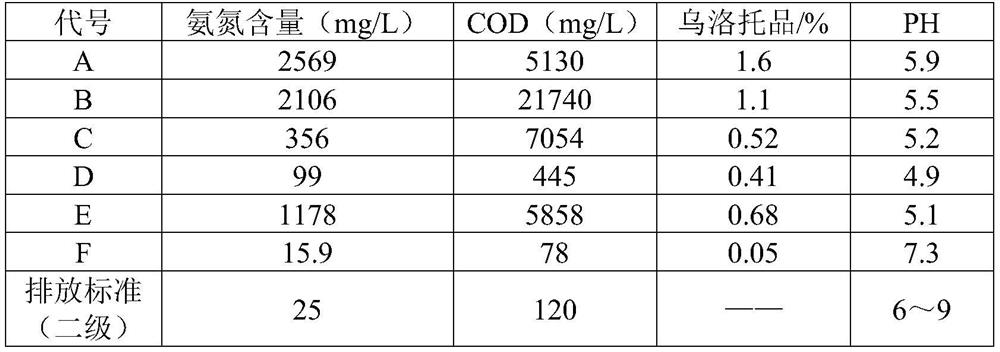A kind of cleaning treatment method of glycine production wastewater
A technology for clean treatment and production of wastewater, applied in natural water treatment, multi-stage water treatment, water treatment parameter control, etc., can solve problems such as increasing system water volume, deteriorating process stability, yield and quality fluctuations, etc., and achieve reduction Ammonia nitrogen content, green production guarantee, simple equipment effect
- Summary
- Abstract
- Description
- Claims
- Application Information
AI Technical Summary
Problems solved by technology
Method used
Image
Examples
Embodiment 1
[0026] Use 31% hydrochloric acid to adjust glycine waste water to pH = 3.5 at 100 m 3 The mother liquor is continuously poured into the first-effect evaporation system (vacuum degree -0.03Mpa, temperature 110°C) for concentration, and the first-effect evaporation condensate (A) is about 32.22 m 3 . The first-effect concentrated liquid is poured into the second-effect evaporation system (vacuum degree -0.07Mpa, temperature 85°C) for concentration, and the second-effect evaporation condensate (B) is about 25.06m 3 . The two-effect concentrated liquid is poured into the decompression flash system (vacuum degree -0.08Mpa) for concentration, and the flash condensate (C) is about 14.32m 3 . The final concentrate was crystallized and centrifuged to obtain 38.7 tons of ammonium chloride. will be 14.32m 3 The flash condensed water is poured into the low-temperature evaporation system (vacuum degree -0.09Mpa, temperature 70°C) to continue to concentrate, producing dilute waste liqu...
Embodiment 2
[0029] Use 31% hydrochloric acid to adjust glycine wastewater to pH=2 at 100m 3 The mother liquor is continuously poured into the first-effect evaporation system (vacuum degree -0.03Mpa, temperature 110°C) for concentration, and the first-effect evaporation condensate (A) is about 30.78 m 3 . The first-effect concentrated liquid is poured into the second-effect evaporation system (vacuum degree -0.07Mpa, temperature 85°C) for concentration, and the second-effect evaporation condensate (B) is about 24.76m 3 . The two-effect concentrated liquid is poured into the decompression flash system (vacuum degree -0.08Mpa) for concentration, and the flash condensate (C) is about 15.12m 3 . The final concentrate was crystallized and centrifuged to obtain 38.7 tons of ammonium chloride. will be 15.12m 3 The flash condensed water is poured into the low-temperature evaporation system (vacuum degree -0.09Mpa, temperature 60°C) to continue to concentrate, producing dilute waste liquid (D)...
PUM
 Login to View More
Login to View More Abstract
Description
Claims
Application Information
 Login to View More
Login to View More - R&D
- Intellectual Property
- Life Sciences
- Materials
- Tech Scout
- Unparalleled Data Quality
- Higher Quality Content
- 60% Fewer Hallucinations
Browse by: Latest US Patents, China's latest patents, Technical Efficacy Thesaurus, Application Domain, Technology Topic, Popular Technical Reports.
© 2025 PatSnap. All rights reserved.Legal|Privacy policy|Modern Slavery Act Transparency Statement|Sitemap|About US| Contact US: help@patsnap.com



